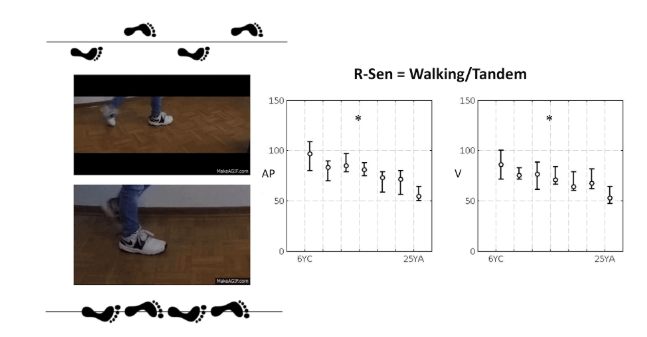When you grow, it is clear that your abilities and movement coordination improve. Consequently, you are able to perform motor tasks that you could not do earlier. Ideally, this is because you acquire the ability to use more complex motor strategies as you mature. The question is, can we measure and analyse this movement complexity? And, if yes, do we expect to see an increase in motor complexity with age, independently from the motor task analysed?
To answer these questions, we studied motor complexity during walking in children, adolescents and young adults. We assessed movement complexity from trunk acceleration data using multiscale entropy. Multiscale entropy expresses the probability that two data traces remain close to each other over time. We examined motor complexity during two different locomotor tasks: i) natural gait, which is a paradigmatic task, expected to become more automatic with age maturation, and ii) tandem gait, which is a non-paradigmatic task that challenges motor control performance, constraining the base of support both in the medio-lateral and antero-posterior directions. We expected motor complexity to decrease during normal walking and an increase during tandem gait with age. Our hypothesis was confirmed, and results showed a significant increase of motor complexity with age in tandem walking and a decrease on the sagittal plane in normal walking. Interestingly, the ratio of motor complexity (R-Sen in Figure below) measured during both tasks started around 100% at six years of age (similar level of complexity), and showed a progressive decrease to 50% in adulthood (with higher complexity in the tandem gait condition).
These results indicated that multiscale entropy is capable to detect changes in movement complexity with motor control maturation. This technique offers new opportunities for improving our understanding on motor control and its development. Our results further reveal a concurrent development of automaticity and complexity. With age maturation, motor complexity decreased during normal walking but increased during tandem walking. This may results from experience obtained during daily life, which leads adults to reach an optimized solution for normal walking, thereby manifesting a decreased movement complexity, while during a novel tandem walking task, they are able to employ more complex motor strategies to successfully perform the task. Finally, our results highlight directionality of changes with age in system complexity, which may depend on the direction of the adaptations or tolerance to stressors.
Figure. An overview of the two walking conditions (left) with normal walking (top) and tandem walking (bottom), and the effect of age on the ratio of complexity during these tasks (right) in antero-posterior and vertical directions.
Publication
M. C. Bisi & R. Stagni (2018): Changes of human movement complexity during maturation: quantitative assessment using multiscale entropy, Computer Methods in Biomechanics and Biomedical Engineering, DOI: 10.1080/10255842.2018.1448392
About the Author

Maria Cristina Bisi
DEI, Department of Electrical, Electronic and Information Engineering, University of Bologna
Maria Cristina Bisi is a post-doctoral fellow at the Department of Electrical, Electronic and Information Engineering of the University of Bologna. Her research activity is mainly focused on the development of quantitative methods for the assessment and the understanding of motor control development during maturation.
Copyright
© 2018 by the author. Except as otherwise noted, the ISPGR blog, including its text and figures, is licensed under a Creative Commons Attribution-ShareAlike 4.0 International License. To view a copy of this license, visit https://creativecommons.org/licenses/by-sa/4.0/legalcode.
ISPGR blog (ISSN 2561-4703)
Are you interested in writing a blog post for the ISPGR website? If so, please email the ISGPR Secretariat with the following information:
- First and Last Name
- Institution/Affiliation
- Paper you will be referencing

